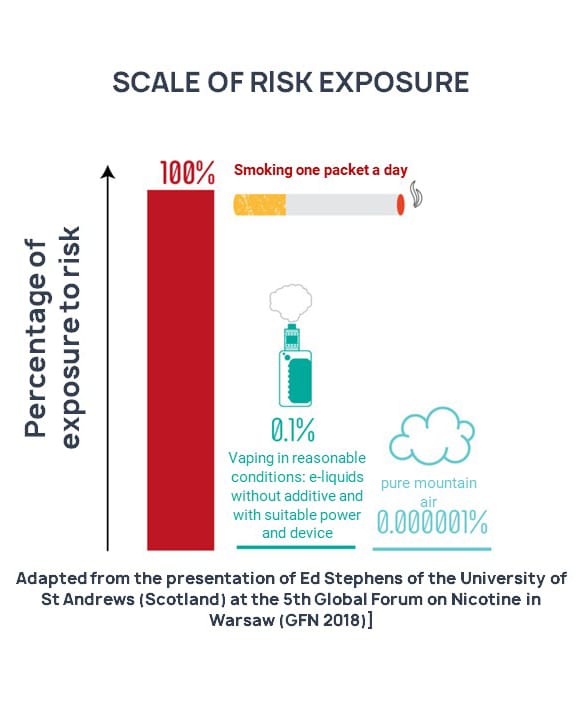Is it too soon to assess the toxicological effects of vaping compared to smoking?
Whenever a vaper talks up the benefits of vaping over smoking at dinner, to friends or smoker colleagues, they will hear this remark at least once: “yes but it is still too soon to assess your vaporiser”.
Here are some answers for your family and friends, anxious about your health.
Firstly, do we need to wait for 40 years of vaping use to estimate the potential risks compared to smoking?
Today we are able to identify the chemical compounds responsible for the harmful effects of smoking. They occupy two families. There are the molecules naturally present in tobacco which are intrinsically toxic. This is the case, for example, for certain tobacco alkaloids such as anabasine or anatabine but also molecules called tobacco nitrosamines. Then, there are the degradation products created on combustion of the plant in the cigarette. These alone are responsible for the main part of the toxicity of smoking and represent several hundreds of compounds1.
The first studies on the composition of the vapour of personnel vaporisers (PV) are logically attempting to look for the presence of the degradation products linked to the cigarette. The results show that among the hundreds of harmful molecules contained in tobacco smoke, only 4 to 5 compounds are found in PV emissions in normal use conditions and in amounts up to 1000 times less important than in tobacco smoke2. The presence of the toxic elements of tobacco (alkaloids and nitrosamines) has also been studied in e-liquids and the vapour. It seems that their quantities are so low that they are difficult to detect2.
It can be seen that the molecules responsible for the toxic effects of smoking in the short and long term are more or less absent from the vapour of a PV in normal use conditions. It may reasonably be thought that the harmful effects of the PV are thus reduced compared to smoking. Nevertheless, in the emissions of a PV, there are molecules absent from tobacco smoke whose safety has to be studied. These are also present in current consumer products and it is unlikely that they cause a public health risk as significant as smoking. Finally, the current development of vaping products is tending rather towards purification of the products and of their emissions3 thanks, in particular, to the drafting of specific standards covering their composition (standard AFNOR XP D90-300 part 2)
In addition, studying the toxicological effects of vaping over a long period, as things stand, is almost impossible because the vast majority of vapers are smokers or former smokers. Thus, it is impossible to establish a causal link between the development of a pathology and vaping with someone who already has a history of smoking. It is now understood that smoking history remains a risk factor for many illnesses and this despite stopping tobacco consumption4.
We therefore have to wait for generations of exclusive vapers to identify the potential long-term risks of vaping while taking into account the variations of many parameters. What performance should be tested? Which liquids? Which vaporisation conditions? What quantities? This would be extremely complex.
Nevertheless, one study has attempted this by observing vapers who never smoked previously. The authors monitored 16 of these vapers for almost 4 years and compared some of their cardiac, respiratory and blood parameters with non-smokers. In the conclusions it is shown that no negative impact of vaping was found on the studied parameters compared with non-vapers and non-smokers5. While they are encouraging, these first results need to be furthered with other studies taking into account a larger number of vapers. But, the main difficulty results from the fact there are few vapers who have never smoked and the financing of this research remains very costly.
References :
- Chen, P. X., & Moldoveanu, S. C. (2003). Mainstream smoke chemical analyses for 2R4F Kentucky reference cigarette. Beiträge Zur Tabakforschung International/Contributions to Tobacco Research, 20(7), 448-458.
- Goniewicz, M. L., Knysak, J., Gawron, M., Kosmider, L., Sobczak, A., Kurek, J., … & Jacob, P. (2014). Levels of selected carcinogens and toxicants in vapour from electronic cigarettes. Tobacco control, 23(2), 133-139.
- Wagener, T. L., Floyd, E. L., Stepanov, I., Driskill, L. M., Frank, S. G., Meier, E., … & Queimado, L. (2017). Have combustible cigarettes met their match? The nicotine delivery profiles and harmful constituent exposures of second-generation and third-generation electronic cigarette users. Tobacco control, 26(e1), e23-e28.
- https://solidarites-sante.gouv.fr/IMG/pdf/Benefices_du_sevrage_tabagique.pdf
- Polosa, R., Cibella, F., Caponnetto, P., Maglia, M., Prosperini, U., Russo, C., & Tashkin, D. (2017). Health impact of E-cigarettes: a prospective 3.5-year study of regular daily users who have never smoked. Scientific reports, 7(1), 13825.










No comment
Be the first to leave a comment